Support of Amazon Ecosystem Conservation Program

Having defined "environmental conservation" as one of the ITOCHU Group Basic Activity Guidelines on Social Contribution, ITOCHU Corporation vigorously pursues environmental conservation activities, thereby contributing to the sustainable development of societies. From FYE 2017, we supported the new concept of "Field Museum," an ecosystem conservation program in the tropical forests of the Amazon promoted by Kyoto University with the National Institute of Amazonian Research.
Background
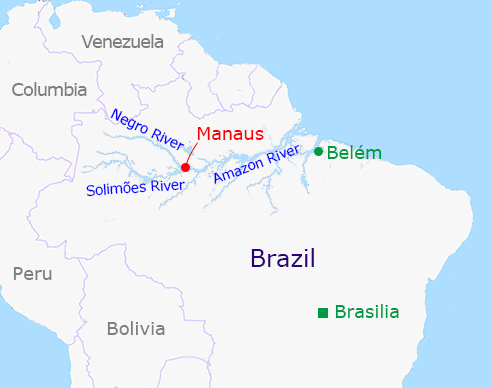
Rainforests cover just 6% of the land area of Earth, but are said to be home to more than half of all species in the world, and thus constitute the ecosystem with the highest biodiversity on the planet.
The Amazon rainforest in particular in the world's largest, accounting for over half of all the rainforest acreage that remains on Earth. In the ten years from 1999, over 1,200 new species of vertebrates have been discovered there, although how they live remains unknown for many.
Sitting at the confluence of the Solimoes River and Rio Negro River at the center of Brazil's Amazon region, the major city of Manaus is surrounded by a particularly diverse and valuable natural environment even for the Amazon, and many national parks and protected areas lie nearby. However, that precious ecosystem is in the process of getting lost owing to the rapid expansion of the city. To solve this problem, research on and preservation of endangered organisms and their habitats, and the creation and maintenance of a society that is environmentally aware by carrying out environmental education for local residents based on accurate information, are essential.
Project Overview
The National Institute of Amazonian Research (INPA) is the region's largest national research institute and it is especially renowned for its research on the biology of the Amazon, yet it is a fact that studies required for conservation and the training of researchers are proceeding too slowly. The new concept of "Field Museum" promoted by Kyoto University with the National Institute of Amazonian Research, which calls for joint conservation research and facilities development by using the advanced technologies that Japan excels at, is expected to dramatically advance conservation research on various organisms and ecosystems, including research on water-dwelling animals (river dolphins, manatees) of the Amazon and the upper canopies of the rainforest, which have been challenging to study until now. The aim of the new concept of "Field Museum" is to contribute to the sustainable development of local communities, not by means of conventional exhibits under glass as in museums, but by conducting research, conservation and dissemination activities that regard the region's nature and the very lives of people as beneficial exhibits, taking advantage of the location of Manaus in the midst of a vast and precious ecosystem.
For conserving an ecosystem in the Amazon, ITOCHU Corporation supported a program for returning rescued Amazonian manatees to nature based on the Field Museum concept and the construction of a facility called the Field Station. The program is structured as a collaboration between the Japan Science and Technology Agency (JST), which provides competitive research funds for science and technology projects, and the Japan International Cooperation Agency (JICA), which provides development assistance (ODA). Based on the needs of developing countries, the program aims to address global issues and lead to research outcomes of practical benefit to both local and global society.
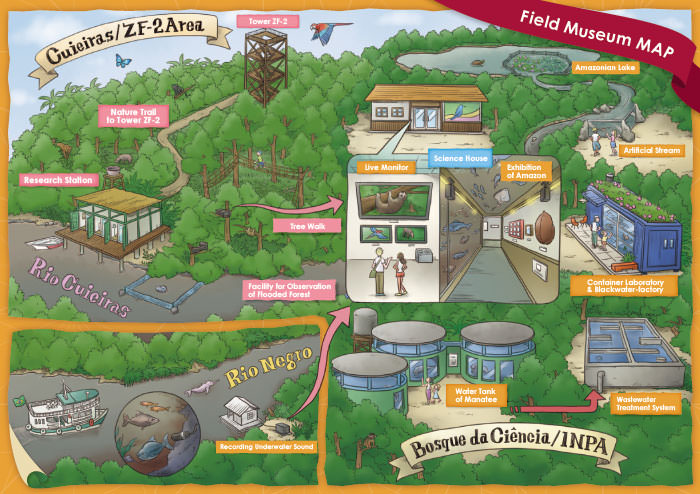
Support activities for the Amazonian manatee
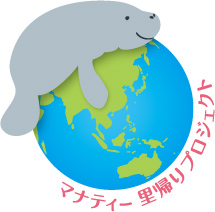
The Amazonian manatee, a large aquatic mammal in danger of extinction, is an endemic species of the Amazon River that is fully herbivorous unlike cetaceans. As the result of massive overhunting in the past, the population has plummeted, and though manatees are currently protected by law, they show no sign of recovering owing to poaching for their meat.
Since 1972, the National Institute of Amazonian Research has been actively protecting and breeding Amazonian manatees, and the Wildlife Research Center of Kyoto University, along with the National Institute of Amazonian Research, aims to establish a release program that returns rescued manatees to nature.
As the number of Amazonian manatees protected by the National Institute of Amazonian Research grew (reaching about 60 in January 2016) and holding tanks became crowded, a release program was launched in 2008 to return both rescued and captive-raised manatees to the wild. The biology and ecology of Amazonian manatees still not being fully understood, only four manatees have been released as of 2016 by the National Institute of Amazonian Research. Further, the captive-raised individuals that were released were found to have difficulty finding food on their own in the natural environment, leading to some individuals becoming weakened and getting rescued again. Further, the Amazon region has a rainy season and a dry season. The rainy season is marked by abundant rainfall, bringing an abundance of grazing vegetation and making travel in rivers easy, whereas during the dry season, which sees scant rain, river levels drop and many tributaries turn into land, restricting the movement of manatees. Even some wild manatees ending up stranded in parched areas have been reported to have died. The variety and amount of grazing plants are known to drop dramatically in the dry season, and captive-raised manatees who are unfamiliar with such environmental changes have a hard time adapting to the wild following their release. Thus to ensure the success of releases, methods that are optimal for manatees need to be developed and established. Further, new techniques for evaluating the manatees' adaptation to nature are also being developed based on observation of their post-release behavior. ITOCHU Corporation supported this program to reintroduce Amazonian manatees into the wild.
Amazonian manatee reintroduction performance indicators
 Please scroll sideways.
Please scroll sideways.
Until Amazonian manatees return to the wild
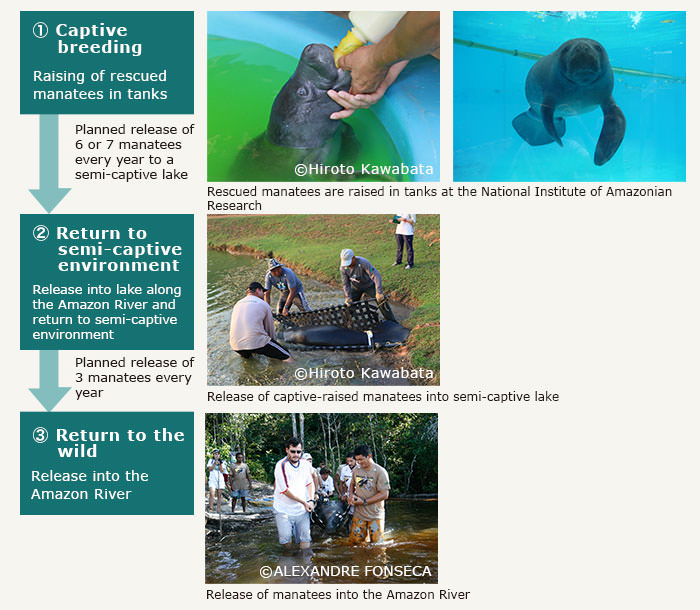
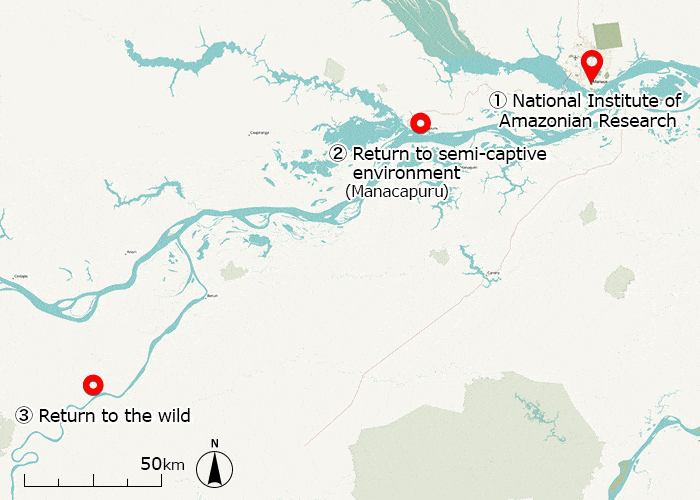
Field Station
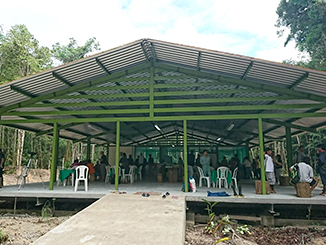
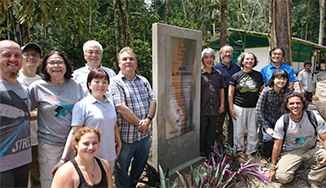
Tropical rainforests in the Amazon are one of the most biologically diverse areas on earth. An area around the upper reaches of the Cuieiras River is home to a particularly wide variety of animals. To advance studies on this precious ecosystem in the Amazon, a Field Station was built in the Cuieiras area, a wildlife preserve designated by the National Institute of Amazonian Research, as one of the core facilities based on the Field Museum concept. ITOCHU Corporation donated 19 million yen to JICA for building and preparing this facility (the Visitor Center) including a cafeteria and an exhibition hall. The facility was completed in March 2018 as a base for nature observation and research. It will act as the world's first base for long-term monitoring studies on animals and plants in Amazonian tropical rainforests which cover both flooded forests and unflooded areas known as terra firme. It will also become a visitors' center that offers chances to come in contact with a wide variety of animals and plants that live in the Amazon to visitors other than researchers. An opening ceremony for this facility was held on May 8, 2018. Participants in this ceremony included President Juichi Yamagiwa of Kyoto University and Jun Inomata, ITOCHU Corporation's CEO for Latin America, among others.
Expected to attract about 500 visitors each year, the Field Station is aimed at educating and enlightening local residents about the environment. In building the facility, approval was obtained from relevant Brazilian government agencies and sufficient consideration was given to the environment after selecting a secondary forest, instead of a primeval Amazonian forest, and confirming the absence of rare species through advance studies on natural surroundings conducted by the INPA. This facility offers opportunities to come in contact with a wide variety of animals and plants that live in Amazonian tropical rainforests and abundant nature there, and contributes to the environmental education of local residents and visitors.
This initiative represents the first case at the JICA in which the academy, the industry and the government work in corporation to conserve an ecosystem in the Amazon. In July 2018, Princess Mako of Akishino visited the National Institute of Amazonian Research and observed Amazonian manatees there during her official trip to Brazil. The visit drew a great deal of attention in Brazil, too.
Research themes currently planned
- Habits of electric fish and small fish
- Seasonal changes of underwater sound in rivers by using acoustic technology
- Return of manatees to the wild
- Investigation of habits of mammals and birds using sensor cameras
- Exploration of flora in flooded forests and other forests
